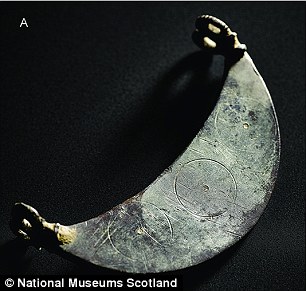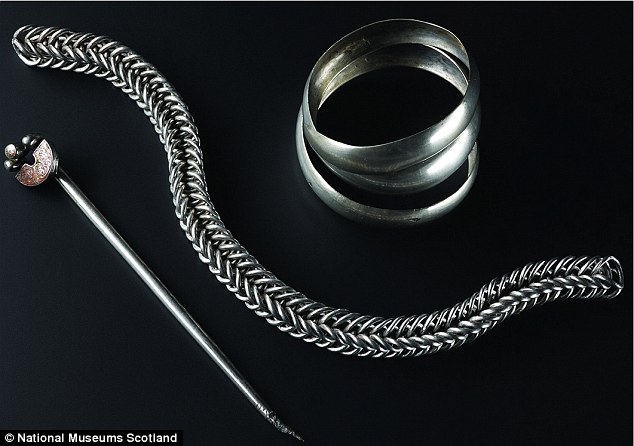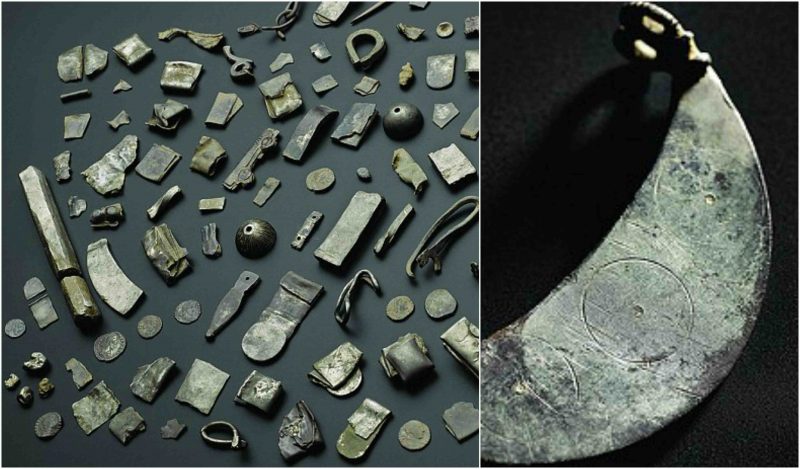The Picts are often stereotyped merely as tattooed barbarians, but this is not a wholly accurate view. While they did have a talent for war, they did also apparently have a high degree of appreciation for art and jewelry. This “lost” tribe of Scottish people carved a beautiful variety of stone and shaped silver in many different forms.
A treasure trove that was recently uncovered can attest to this talent. In a field in Northern Scotland, archaeologists have found a hoard of more than 100 pieces, including coins, pieces of brooches and bracelets, Roman military equipment, ingots, and Hacksilber parcels, which are fragments of cut, bent, and broken silver. All date back to late Roman times. One of the most beautiful pieces found is a lunate/crescent-shaped pendant with two double-loops. The hoard is being called the Gaulcross treasure.
According to researchers, the silver hand-pins and bracelets are incredibly uncommon finds for the area. They also noted that most of the artifacts likely belonged to the elite social classes.

Source National Museum Scotland
The team of archeologists to study this site is led by Dr. Gordon Noble, senior lecturer in the department of archaeology at Aberdeen University. The study, which was co-authored by Martin Goldberg, from National Museums Scotland, was reported in the journal Antiquity.
Commenting on the find, Goldberg said, “Like other hoards, the Gaulcross treasure has ‘preserved fashions (from) what we think of as the darkest bits of the dark age after the fall of the Roman Empire…It’s like a little snapshot in time.”
Researchers have dated to silver in the hoard back to the sixth or seventh century AD, and according to the paper, this was after the Romans decamped and before the Vikings stormed onshore.
The Picts were a group of tribes that lived north of the Forth and Clyde during the Late Irons Age and Early Medieval period. When many people think of Picts, they picture Mel Gibson’s blue face paint in the movie Braveheart. The paint was a nod to the Pict tradition of body-paint. This is probably why the Romans gave the tribe the name Picti, meaning “painted people.” What the Picts called themselves, however, is not known.

Despite the fact that the group lived in the cold Scottish climate, their warriors would wage war stark naked. This custom carried on until well into the 5th century, and it didn’t seem to affect the tribe’s ferocious reputation.
By the late 200s AD, the Picts had overrun the northern frontier of the Roman empire multiple times. These naked fighters are one of the main reasons that the heavily-armored Roman legions were unable to conquer the area.
The site, Gaulcross, is currently an intensively farmed field located in rural Aberdeenshire. Back in 1838 — about 170 years ago — this was not the case. Two man-made stone circles used to stand in the field. One dated back to the Neolithic and the other to the Bronze Age (1670 BC to 1500 BC). Three silver objects were discovered near those circles, but instead of looking for more treasures relating to those three, the discoverers were ordered to turn the field into farmland. There is no evidence today that the prehistoric circles ever existed.
“We set out, not really thinking we would find more silver,” Dr. Noble said. “We just wanted to learn more about the context’ of the original find.”
Apparently, during the eighteenth and nineteenth centuries, many artifacts were uncovered and destroyed in favor of agricultural improvement and expansion, explained the researchers. The discoveries made were often inadequately reported.
One of the reasons why this find is so extraordinary is that the Picts often recycled what silver they had. This made finding such artifacts rare; most piece would have simply become a part of some other item. For whatever reason, the artifacts in the Gaulcross hoard were not melted, but instead were buried, which allowed researchers to discover them hundreds of years later.
During the process of digging up the hoard, the researchers have found the importance of using modern techniques to investigate old finds. In the study published, they wrote, “Here, we highlight the potential of re-investigating antiquarian finds for research purposes, using modern investigative techniques to provide information otherwise lacking for so many old finds.”
Dr. Blackwell was particularly interested by bangle that was found folded into a parcel with a late Roman coin (dated from 4th to early 5th century AD) sandwiched between the folds. There were multiple parcels, and some of the research being done now is to see whether there are any uniform weights of the parcels, perhaps corresponding to the Roman weight system. There is a theory that the aforementioned parcel with the bangle and the coin might have been deliberately made to weigh 1/3 of a Roman ounce.
What makes that parcel even more intriguing to experts is that it is a meeting of local and Roman objects. Alone, the bangle is an incredibly rare find, but to find it together with a Roman coin, that’s what makes the parcel special. Of course, by the time of their burial, the two artifacts were more treasured for their silver bullion, rather than as either a coin or bangle.

Now, there are organizations that want to revisit the sites of these forgotten discoveries. For the Gaulcross site, the year 2013 found two projects willing to come together to reopen the area as an archeological dig. The first organization is called Northern Picts Project. Established in 2012 and hosted by the University of Aberdeen, the organization targets key Pictish sites in northern Scotland. The second was the National Museums Scotland Glenmorangie Research Project (established 2008). It has been promoting material culture approaches to the study of early medieval Scotland.
The choice to revisit the Gaulcross site has been a rewarding one. “It’s a real melting pot of different objects and different cultural origins,” Dr. Noble said. “It’s a really fascinating hoard.” He continued, saying that new fieldwork has revealed that the Gaulcross hoard was much larger in size than previously thought. It is also the northernmost Hacksilber hoard in Europe and one of only two comparable hoards known in Scotland.
“This hoard shows that the Picts had access to quantities of silver and were, not surprisingly, carefully managing what was a precious resource,” Dr. Alice Blackwell, a Glenmorangie Research Fellow at National Museums Scotland. She was involved in the study and told MailOnline, “Many of the objects have been cut up ready to be melted down and made into new things. Until now, we’ve had only one other hoard, from Fife, that could shed light on this process of making and remaking, and many of the objects within that hoard were unique.” She continued, “Now we have an additional 100 objects with which to ask questions about the range of contacts the Picts had, about how they acquired Roman silver in the first place, about the sorts of new power symbols they made from it.”
